- With respect to Bandhani article gives history, making
of Bandhani, design types and colours used.
The
history of dyeing can be dated back to pre-historic times. This art finds its
mentions in Alexander’s time texts about the beautiful printed cottons of
India. As per evidence in historical texts, the first Bandhani saree was worn
at the time of Bana Bhatt`s Harshacharita in a royal marriage. It was believed
that wearing a Bandhani saree can bring good future to a bride.
Ajanta
walls stand for the evidence of Bandhani sarees. The dyers have experimented
with the use of different elements, both natural and man-made, for ages. Also,
there are experiments with different binding/tying techniques to create
patterns on cloth immersed in containers of dye.
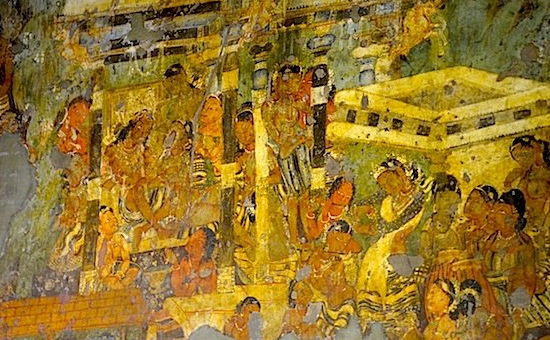 Textile traditions painted in Ajanta Caves. Pic Shefali Vaidya.
Textile traditions painted in Ajanta Caves. Pic Shefali Vaidya.
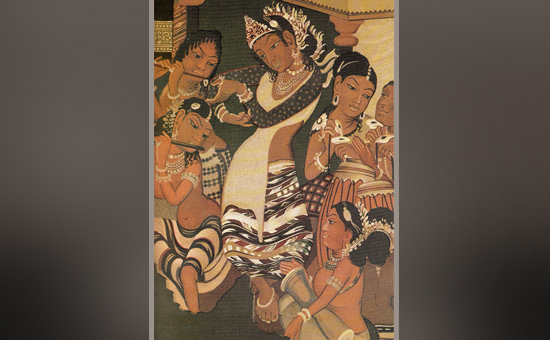 Another Ajanta pic, close up.
Another Ajanta pic, close up.
Different types of tie and dyes have been practiced in India, Japan, and Africa for centuries. Tie-dye became fully developed in China during the T’ang dynasty (618-906 A.D.) and in Japan during the Nara period (552-794 A.D.)
Reference
and see pics
Types of Tie and Dye
Tie
dying is a resist process that may be used on thread before it is woven (to
produce ikat), or on woven cloth. The process of tying parts of cloth tightly
before submerging in dye, leaving areas undyed, is used in two classic Indian
exports – Bandhani and Leheryia.
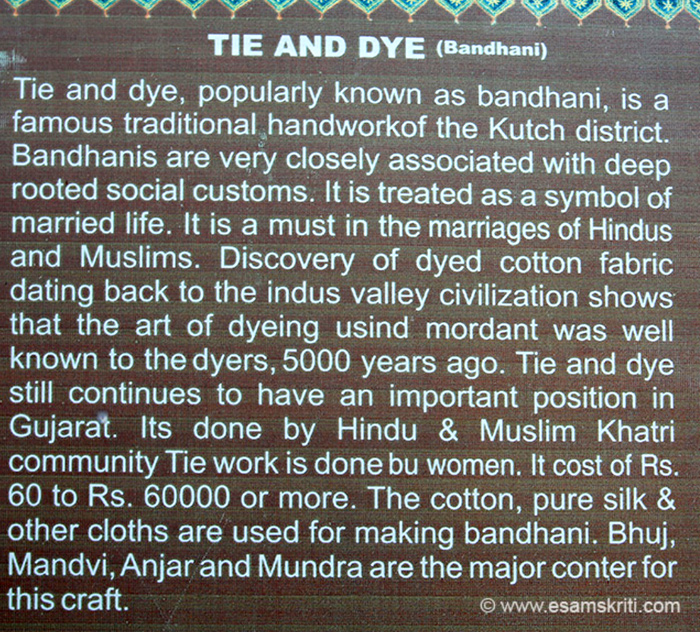 At Bhujodi village Kutch.
At Bhujodi village Kutch.
Bandhani
The
term `Bandhani` is derived from the word Bandhan
that means tying up. It is an ancient art practise that is mainly used in the
states of Rajasthan and Gujarat. Some 5000 years ago Indian Tie & Dye or
Bandhani started. Places in Rajasthan like Jaipur, Sikar, Bhilwara, Udaipur,
Bikaner, Ajmer, and Jamnagar in Gujarat are the well-known centres producing
odhnis, sarees and turbans in Bandhani.
Different
communities in Rajasthan have, for ages, followed the tradition on tying
turbans with different patterns of bandhani on their heads. These were used to
identify which community the person belonged to. In the early days dyes were
extracted from roots, flowers, leaves, and berries.
Read
About
Turbans of India and in detail History of Bandhani
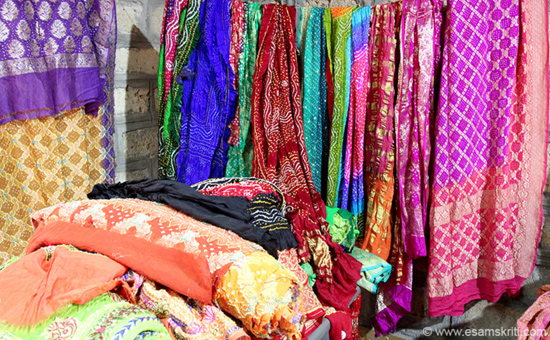 Bandhani on display, Bhujodi village Kutch.
Bandhani on display, Bhujodi village Kutch.
Bandhani
work in India was started by the Muslim Khatri Community of Kutch. The
tradition has passed on from one generation to the other. The art of Bandhani
is a highly skilled process. The technique involves dyeing a fabric which is
tied tightly with a thread at several points, thus producing a variety of
patterns like Leheriya, Mothra, Ekdali and Shikari depending on the manner in
which the cloth is tied. The final products are known with various names like
Khombi, Ghar Chola, Patori and also Chandrokhani etc.
Reference and to see pics
Leheryia
Leheryia
is a Hindi word meaning ‘waves’. The cloth is rolled wet around a wooden pole
and bound tightly at intervals to create lines. By rolling diagonally the
resulting pattern is diagonal stripes, which can be produced in multiple
colours by untying some sections after the first dye bath, and tying new
sections. A chequered pattern can then be produced by unrolling the cloth and
rolling from the opposite corners.
As
with Bandhani, Leheria has been imitated in print, making it easier to
mass-produce, and therefore sell cheaply. It may be argued that this was not a
case of trying to counterfeit the tie dye technique, but to emulate, and
perhaps surpass it. However, it should be noted that a true tie-dyed product
will be sold with some of the ties still intact, to evidence its authenticity.
To
see pictures
The Tie and Dye Technique
Tie
and Dye is an easy way to add a variety of colourful designs and vibrant style
to your wardrobe. Brilliant effects are created by binding, folding or simply
scrunching fabric before dyeing it.
"Tie and dye" is the process of creating patterns on clothes or fabrics. It is dying natural fabrics that results in interesting and colourful patterns. The technique of tying of cloth with thread and then dying it is the simplest and perhaps the oldest form of creating patterns on a plain piece of cloth is known as tie and dye.
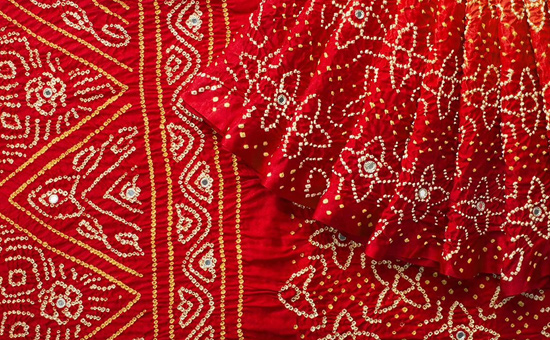 Bandhani
Bandhani
Tie
and dyeing need not be limited to clothes. Stunning effects can also be
achieved on household items such as pillowcases, napkins and tablecloths. The
technique involves spirals, marbling, diamonds ovals squares, knotting,
crumpling, pleating or folding the fabric into various patterns, then tying it
with string.
Reference
and pictures
Steps Involved and Resulting Patterns
The
area of fabric to be dyed is outlined lightly in the colour of choice. Next, a
thin sheet of clear plastic is placed on top. This plastic has pin-sized holes
over the indicated area, and the colour and pattern desired is transferred onto
the fabric.
The
dyer then finds a spot with an imprint of the hole and pulls a small amount of
fabric through, winding thread around the cloth and coming through the hole to
form a small knot. After all knots are tied, the fabric is washed to remove the
imprints left. After this, the cloth is dipped in a chemical called naphthol for
five minutes, and then in a light colour dye for another two minutes.
The
fabric is rinsed, excess liquid squeezed out, and then it is dried, tied, and
dipped again in a darker colour. The cloth is left alone for three to four
hours as the colours soak into the desired areas, allowing the fabric beneath
the threaded knots to remain undyed.
Once
completed, the fabric is washed and starched as required. Once dry, the makers
pull apart the fabric in a very precise way to release the tied knots and reveal
the unique pattern of blank dots beneath them. The result of this Bandhani tie and
dye technique is a beautifully dyed fabric with elaborate shapes and designs,
such as flowers and bells.
Reference
The most common clusters and patterns of knots made
from clusters, each with their own name.
•
Ekdali: single dot.
•
Tikunthi: three dots that make circles and squares.
•
Chaubundi: four dots.
•
Satbandi: dots in groups of seven.
•
Boond: small dot with a dark center.
•
Kodi: tear or drop-shaped pattern.
•
Dungar Shahi or Shikargah: a mountain like pattern.
•
Jaaldar: web like pattern.
•
Beldaar: vine like pattern.
•
Laddu Jalebi: swirling pattern.
•
Leheriya: wave-like pattern.
Reference
Colours Used
Just
as the patterns of Bandhani dyeing hold deep meaning, so do the colours.
Traditionally,
only two colours are used at a time. When this type of tie & dye began, the
colours yellow and red, which are lucky in Indian culture, were used. In the
Bandhani technique now, bright colours such as yellow, red, green, and pink are
used in various shades.
While
the colours vary in modern times, certain ones still hold huge cultural
meaning. Red represents a bride or woman who was recently married, and yellows
are used for a new mother.
Reference
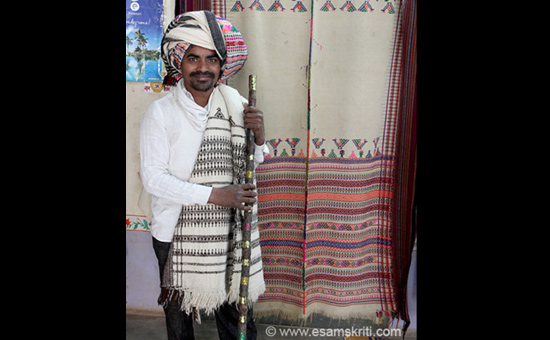 Ramji, expert tie&die
village Sumrasar near Bhuj, Kutch. Tel 9998082332.
Ramji, expert tie&die
village Sumrasar near Bhuj, Kutch. Tel 9998082332.
The Making of Bandhani
The
process starts by drawing a design on stencil paper that is then punched with
needles. A fugitive dye is then brushed through the paper, imprinting the
design directly on the fabric.
The
base fabric can be fine silk or cotton, or even wool. A fine silk cloth can be
folded in two for a symmetrical design or to make two scarves, thereby saving
time. The tying of the pattern with thread to form the resist is next. This
step is generally women’s work as it is portable; men do the dyeing.
Most
widely used is the simple dot (bindi) which is formed by pinching a small area
of cloth and tightly wrapping cotton in one continuous connect-the-dots around
the raised parts. Using a metal tube through which the cotton thread is fed
facilitates the winding around the dots. Once the wrapping is complete, the
fabric goes into the dye bath, the dye squished into the fabric to make sure it
penetrates.
The
binding resists the dye from reaching that part of the cloth so when the thread
is removed, the undyed circle is revealed. Once the scarf is dyed and dried,
the knotting is removed simply by pulling on both ends of the cloth.
Reference
Steps Involved
The
area dyed is outlined using fugitive colours. Then place a transparent thin
sheet of plastic, which has pin holes over this area of the fabric and using
fugitive colours transfer an imprint of the desired pattern onto the fabric.
The
artisans then pulls on a small area of the fabric where there is an imprint of
hole and winds thread tightly around the protruding cloth to form a knot or
bhindi. The thread generally used is nylon thread.
After
tying the knots the fabric is thoroughly washed to remove the imprint. The
cloth is then dipped in napthol for five minutes and dyed in yellow or another
light color for two minutes.
Next
it is rinsed, squeezed, dried and then tied again and dipped in a darker color.
This
is kept for three to four hours (without opening the knots) to allow the color
to soak in. During this process the small area beneath the thread resists the
dye leaving an undyed dot. This is usually carried out in several stages starting
with a light color like yellow, then after tying some more knots a darker color
is used and so on.
Reference
After
the last dyeing process has been completed the fabric is washed and if necessary,
starched. After the fabric is dried, its folds are pulled apart in a particular
way releasing the knots and revealing their pattern. The result is a usually
deep colored cloth with dots of various colours forming a pattern.
Very
elaborate motifs are made, in tie and dye work. These include flowers,
creepers, bells and jalas. Knots are placed in clusters each with a different
name, for example, a single dot is called Ekdali, three knots is called
Trikunti and four knots is called Chaubundi. Such clusters are worked
intricately into patterns such as Shikargah (mountain‐like), Jaaldar
(web‐like), Beldaar (vine‐like) etc.
Some of the most common designs are -
Dungar
Shahi – the mountain‐pattern
Chaubasi
- in groups of four
Tikunthi
- circles and squares appear in a group of three
Satbandi
- in groups of seven
Ekdali
- a dot
Boond
- a small dot with a dark centre
Kodi
- tear or drop shaped.
Reference
Laddu Jalebi (after the name of Indian
Sweet) - the swirling
Rajasthan
is well known for its Leheriya pattern or pattern of waves, which symbolizes
water waves. Only two colours are used which alternate each other in a pattern
of stripes arranged diagonally. Originally, the two colours used were the
auspicious colours of yellow and red. The dominant colours in Bandhani are
bright like yellow, red, green and pink. Maroon is also an all‐time favourite.
The Bandhani fabric is sold with the points still tied and the size and
intricacy of the design varies according to the region and demand.
In
Bandhani, different colors convey different meanings. While red represents a
bride or recently married girl, a yellow background suggests a lady has become
a mother recently. Also, the colours and patterns indicate the community the
girl belongs.
Reference
In Today’s Times
Today,
the Khatri community is the main producer of Bandhani in Gujarat, maintaining
an authority of the craft that has been passed down for generations. The demand
for intricate designs featuring Bandhani is high, and the newest patterns can
feature as many as one lakh ties.
Bandhani
is used for daily attire and for important and auspicious occasions, like
births, weddings, temple pilgrimages and more. One of the oldest forms of
surface art-work done on textiles, Bandhani also has its mention in some old
Indian scriptures and manuscripts.
Women
from various communities and religions, especially in north and north-western India,
pass on bandhani clothes as family heirloom.
Reference
The purpose of this compilation is to document and promote. We have given credits and reference links in this compilation along with third party links too. In case some are missed, it is not with malafide intent. Please email full details to esamskriti108@gmail.com and we shall
effect the change.
To read all
articles by author
To
read all articles on Traditional Textiles of India